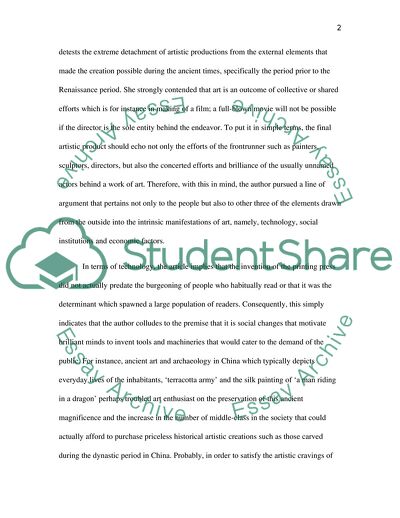
- Home
- Free Samples
- Premium Essays
- Editing Services
- Extra Tools
- Essay Writing Help
- About Us
- Studentshare
- Subjects
- Miscellaneous
- Art History (Critical Analysis)
Art History (Critical Analysis) - Essay Example

- Subject: Miscellaneous
- Type: Essay
- Level: Ph.D.
- Pages: 4 (1000 words)
- Downloads: 0
- Author: bartonarchibald
Extract of sample "Art History (Critical Analysis)"
manity and those that emerges from now forward and is continuing roughly relevant today embodies the most significant violation in the entire evolutionary process of art. It is merely the works created on the contemporary world that represent the existing and the living, modern literature directly addresses to people’s current dilemmas. Janet Wolff (1993) in his article entitled Social Production of Art has eloquently argued about the divide between the artistic independence of the eighteenth century and the social, political and economic determinism of cultural production of the proceeding period until the present age.
The author’s main argument is that artistic creation is more productive if it reflects the configuration and actuality of the progress of societal components as well as the dynamism of the social forces that impinge on the existence of every individual on a daily basis. Wolff, in presenting her argument, sounds like she detests the extreme detachment of artistic productions from the external elements that made the creation possible during the ancient times, specifically the period prior to the Renaissance period.
She strongly contended that art is an outcome of collective or shared efforts which is for instance in making of a film; a full-blown movie will not be possible if the director is the sole entity behind the endeavor. To put it in simple terms, the final artistic product should echo not only the efforts of the frontrunner such as painters, sculptors, directors, but also the concerted efforts and brilliance of the usually unnamed actors behind a work of art. Therefore, with this in mind, the author pursued a line of argument that pertains not only to the people but also to other three of the elements drawn from the outside into the intrinsic manifestations of art, namely, technology, social institutions and economic factors.
In terms of technology, the article implies that the invention of the printing press did not actually predate the
...Download file to see next pages Read MoreCHECK THESE SAMPLES OF Art History (Critical Analysis)
Psychology: Clinical Assessment
Forensics Collection and Analysis of Evidence
Significance of Qualitative Methods in Clinical Psychology
Psychology of Science and Art
The Effectiveness of the Florida Department of Corrections Residential Substance Abuse Treatment
Analysis of Articles about Art History
Critical Discourse Analysis
Leadership in Nursing: Increased Response to Critically Ill Patients at the Emergency Department

- TERMS & CONDITIONS
- PRIVACY POLICY
- COOKIES POLICY